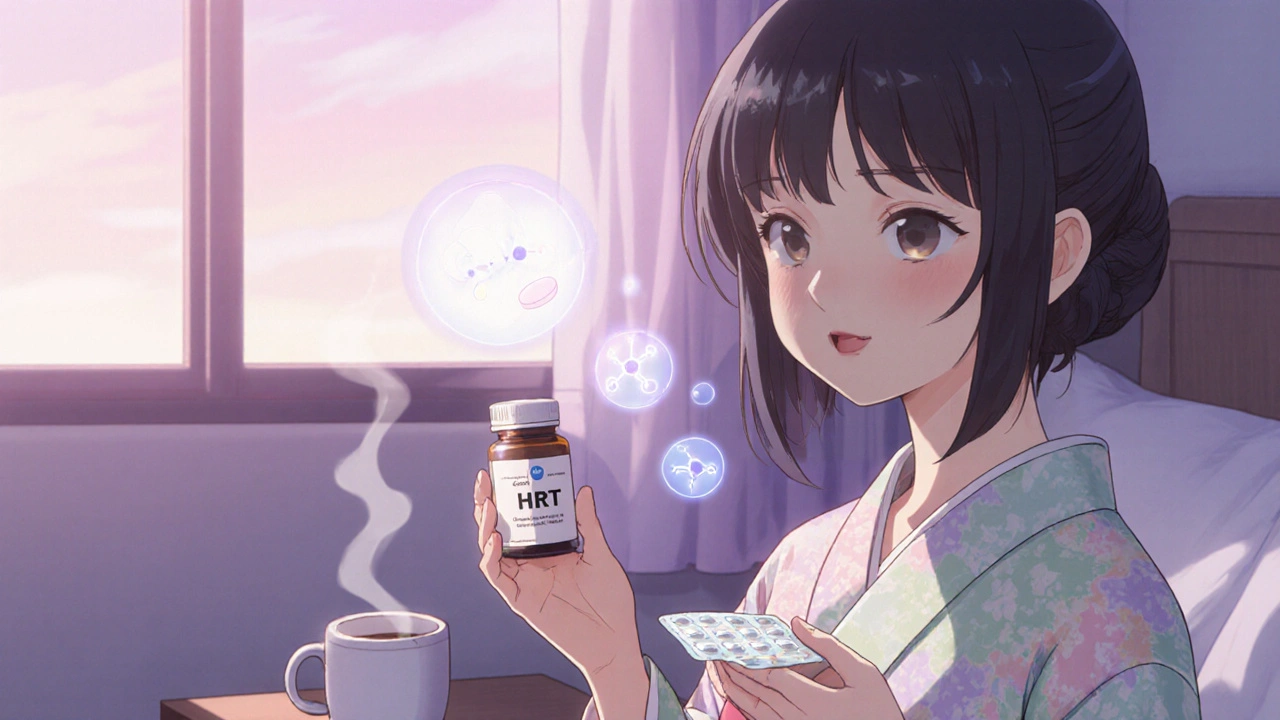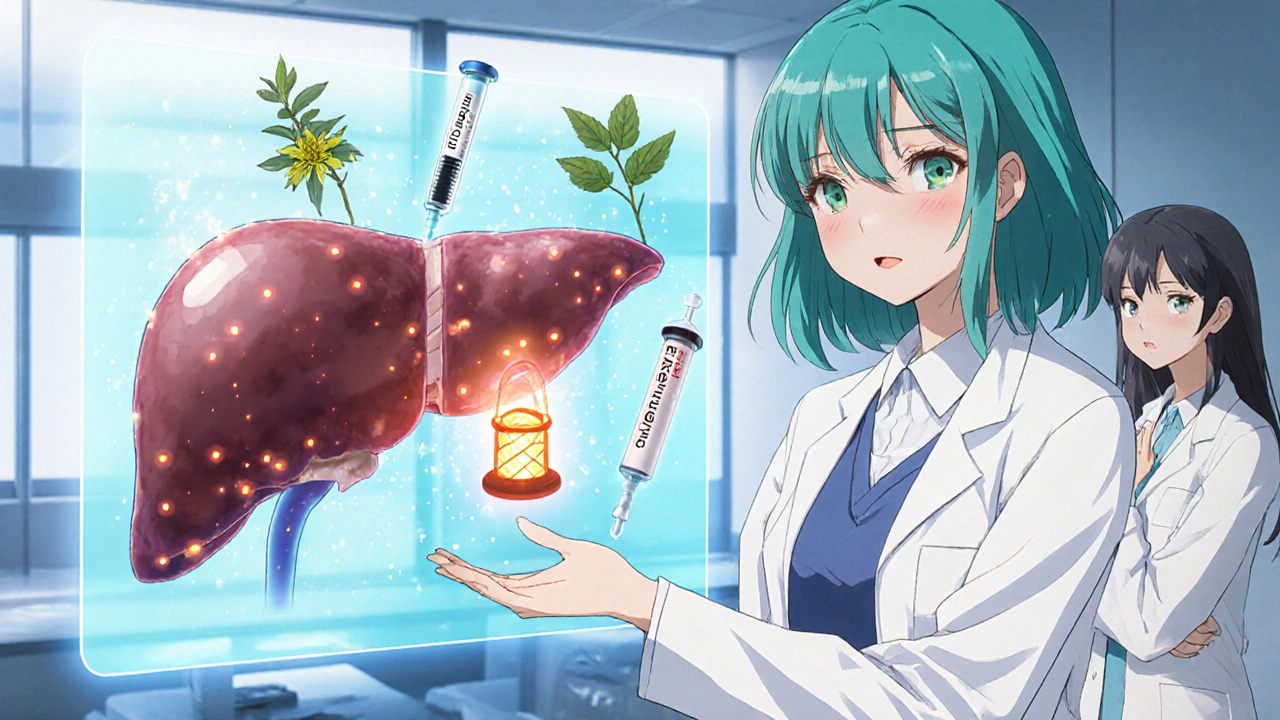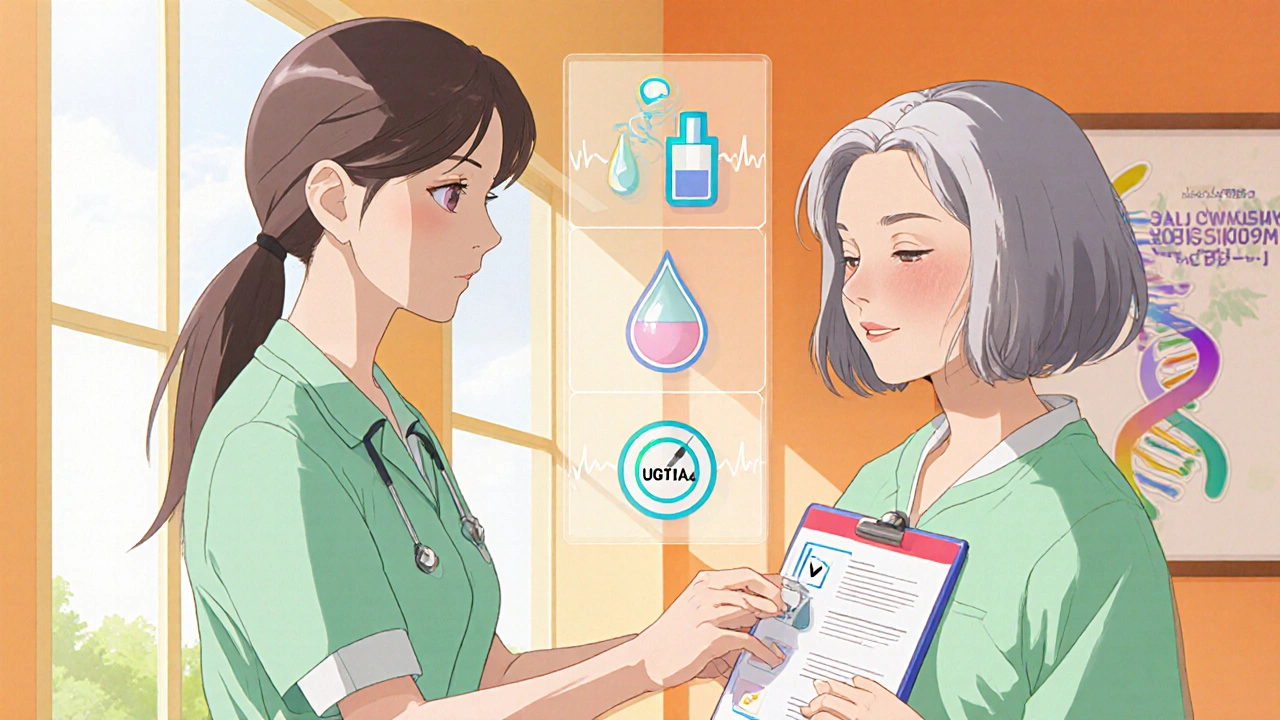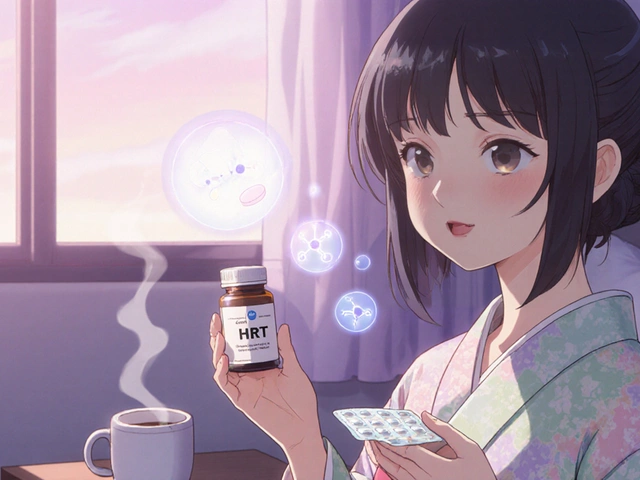
HRT Drug Interaction Checker
Check Your Medications
Quick Takeaways
- HRT drug interactions can change how other meds work, especially anticonvulsants and anticoagulants.
- Oral HRT has more documented interactions than transdermal patches.
- Estrogen can boost the UGT1A4 enzyme, dropping lamotrigine levels by up to 60%.
- Herbal St. John’s wort, some antibiotics, and HIV meds may reduce HRT effectiveness.
- Talk to your prescriber about every supplement, over‑the‑counter drug, and prescription before starting HRT.
What is Hormone Replacement Therapy?
Hormone Replacement Therapy (HRT) is a treatment that supplies estrogen, progestin, or both to women whose natural hormone levels have dropped during menopause. The goal is to ease hot flashes, night sweats, mood swings, and vaginal dryness while protecting bone health.
In the United States, most women use a combination of estrogen and progestin for post‑menopausal symptoms, but there are also estrogen‑only and progesterone‑only options for specific cases.
How HRT Is Delivered
Three delivery methods dominate the market:
- Oral tablets or capsules - the classic pill form.
- Transdermal patches - a skin‑applied system that releases hormones steadily.
- Topical gels or sprays - similar to patches but applied in a cream‑like form.
Transdermal routes bypass the liver’s first‑pass metabolism, which means fewer drug‑interaction surprises. Oral HRT, however, travels through the gut and liver, exposing it to enzymes that can be turned on or off by other medicines.
Why Interactions Matter
Any medication that changes hormone levels can also shift the balance of other drugs. The most serious outcomes are:
- Loss of seizure control for people on anticonvulsants.
- Unexpected bleeding or clotting for patients on anticoagulants.
- Fluctuating blood pressure when HRT mixes with certain antibiotics.
- Misreading cortisol tests because estrogen raises corticosteroid‑binding globulin (CBG).
Because many of these effects are invisible until a problem surfaces, clinicians stress proactive monitoring.

Key Interaction Mechanisms
Lamotrigine is an anticonvulsant used for epilepsy and mood‑stabilization. When a woman starts estrogen‑containing HRT, the liver enzyme UGT1A4 (uridine‑diphosphate‑glucuronosyltransferase 1A4) often ramps up. This enzyme attaches a glucuronic acid molecule to lamotrigine, speeding its clearance. Clinical case reports show blood levels can fall by 30‑60% within weeks, which may trigger seizures or a return of depressive symptoms.
Estrogen also raises the amount of corticosteroid‑binding globulin (CBG). More CBG ties up cortisol, so total cortisol readings look high even though the free, active cortisol may be unchanged. This makes it hard to gauge hydrocortisone dosing in women on HRT.
Herbal St. John’s wort (Hypericum perforatum) activates the cytochrome P450 3A4 system, which can lower oral estrogen concentrations by up to 50%. The result: reduced symptom relief and a false sense of treatment failure.
Antibiotics like rifampicin, antiretrovirals such as efavirenz, and some tuberculosis medicines also trigger liver enzymes that speed up estrogen metabolism, again weakening HRT.
Medication Classes Most Likely to Interact
Below are the biggest culprits, based on NHS, Lareb, and MedlinePlus data:
- Anticonvulsants - lamotrigine, carbamazepine, phenytoin.
- Anticoagulants - warfarin, direct oral anticoagulants.
- Antibiotics - rifampicin, fluoroquinolones.
- Antiretrovirals - efavirenz, nevirapine.
- Herbal supplements - St. John’s wort, ginkgo, high‑dose resveratrol.
- Vitamin K - can offset warfarin if combined with estrogen‑containing HRT.
Any drug with a narrow therapeutic index deserves extra attention because a small shift can push levels into a dangerous zone.
Oral vs. Transdermal: A Side‑by‑Side Comparison
| Formulation | Typical Interactions | Overall Risk Level |
|---|---|---|
| Oral tablets/capsules | Anticonvulsants, antibiotics, antiretrovirals, St. John’s wort, warfarin | High |
| Transdermal patch | Fewer enzyme‑mediated effects; still possible with strong CYP inducers | Moderate |
| Topical gel/spray | Similar to patch; occasional interaction with high‑dose CYP inducers | Moderate |
The table shows why many clinicians start patients on a patch when they already take multiple prescriptions.
Real‑World Example: Lamotrigine and Femoston
In September 2022, the Netherlands Pharmacovigilance Centre Lareb published a case where a woman on long‑term lamotrigine began taking Femoston (an estradiol/dydrogesterone combo). After five months her lamotrigine levels dropped dramatically, her mood worsened, and the doctor had to raise the lamotrigine dose by 50% to regain stability. The incident triggered a Europe‑wide label update adding a warning about possible lamotrigine‑HRT interactions.
This story illustrates three lessons:
- Enzyme induction can happen fast-monitor within weeks.
- Even widely used products like Femoston can surprise you.
- Clear communication between neurologist, gynecologist, and pharmacist saves time.

Practical Steps for Patients and Clinicians
When starting or changing HRT, follow this checklist:
- Make a complete medication list-including OTC drugs, vitamins, and herbs.
- Identify high‑risk drugs (anticonvulsants, warfarin, St. John’s wort).
- Choose the formulation with the lowest interaction potential-usually a patch.
- Order baseline labs: liver enzymes, coagulation profile, and, if on steroids, cortisol free fraction.
- Set a follow‑up at 4‑6 weeks to check symptom relief and any lab changes.
- If you’re on lamotrigine, schedule a therapeutic drug monitoring (TDM) test before HRT, then again 2-3 weeks after starting.
- Document any new side effects-headache, visual changes, sudden swelling-right away.
Clinicians should also update the electronic health record with an “interaction alert” flag so future prescribers see the warning.
Monitoring Tools and When to Seek Help
Key signs that an interaction is happening include:
- Return of seizures or mood swings in patients on anticonvulsants.
- Unexplained bruising, prolonged bleeding, or clot‑related pain.
- Sudden severe headache, visual disturbances, or speech problems-possible stroke signs.
- Swollen hands, feet, or ankles when combining hydrocortisone with testosterone‑containing HRT.
If any of these appear, contact a healthcare professional immediately. In emergency situations (stroke‑like symptoms), call emergency services.
Future Directions in HRT Interaction Research
Post‑marketing surveillance, like the Lareb system that caught the lamotrigine case, is expanding across Europe and North America. Researchers are also using real‑world data from pharmacy claims to map interaction patterns more precisely. Some trials are testing “personalized HRT” where hormone doses are adjusted based on genetic markers for enzyme activity (e.g., UGT1A4 polymorphisms).
Until those tools become routine, the best defense stays simple: thorough medication review, choosing the right formulation, and close lab monitoring.
Frequently Asked Questions
Can St. John’s wort make my HRT stop working?
Yes. St. John’s wort activates liver enzymes that can cut oral estrogen levels in half, so you may feel your hot flashes return. Talk to your doctor before using any herbal supplement.
Do transdermal patches eliminate all drug interactions?
Not entirely. Patches avoid many liver‑enzyme effects, but strong CYP inducers (like rifampicin) can still lower hormone levels. They are just less likely to interact than pills.
How often should my lamotrigine level be checked after starting HRT?
Check a baseline, then repeat the test 2-3 weeks after HRT begins. If the level drops, your doctor may increase the dose and re‑check after another few weeks.
Will taking HRT affect my blood clotting medication?
Estrogen can make blood thicker, which may raise the dose needed for warfarin or direct oral anticoagulants. Your anticoagulant clinic should monitor INR or drug‑specific levels more frequently when you start HRT.
Is cortisol testing useless while on HRT?
Total cortisol looks high because estrogen raises CBG, but free cortisol may stay the same. For patients on hydrocortisone, doctors rely on clinical signs and, if needed, free‑cortisol assays instead of total cortisol.
Keeping an eye on how HRT plays with other meds isn’t glamorous, but it’s the difference between a smooth menopause journey and a medical emergency. Stay honest with your health team, choose the formulation wisely, and monitor regularly-you’ll get the relief you need without unexpected surprises.



Listen up-this HRT interaction nightmare is a betrayal of our women! 💥💊
thanks for the heads‑up really helpful staying positive and checking meds together
The epistemic ramifications of estrogen‑mediated enzyme induction transcend mere pharmacokinetics ;). One must contemplate the ontological hierarchy of drug–hormone symbiosis. Yet the clinical narrative remains stubbornly reductionist, ignoring the subtle dialectic between hepatic biotransformation and patient autonomy. In this light, the guide serves as a palimpsest upon which future therapeutic philosophies may be inscribed. Ultimately, the discerning practitioner will navigate these interstices with both rigor and grace.
Seeing all these warnings makes me wonder if HRT is worth the hassle.
Oh, what a surprise, another medical guideline asking us to become detectives over our own prescriptions. The sheer joy of having to track enzyme induction while trying to survive menopause is simply unparalleled. First, we are told that oral estrogen can slough off lamotrigine levels by up to sixty percent, because why wouldn’t the liver want to be that efficient? Then, as if that weren’t enough, St. John’s wort waltzes in and halves the hormone concentration, turning hot flashes into a full‑blown sauna party. Let’s not forget the anticoagulants, whose delicate balance gets tossed like a salad when estrogen decides to thicken the blood. The list goes on with rifampicin, efavirenz, and a parade of other cytochrome‑inducing agents, each eager to sabotage our therapeutic goals. Of course, the solution presented is a humble patch, because apparently the skin is the new savior of modern medicine. Yet even patches are not immune to the mighty CYP‑inducers that lurk in our drug cabinets. The paradox is delicious: we are forced to monitor labs, adjust doses, and schedule extra appointments, all to maintain the illusion of control. Meanwhile, the pharmaceutical industry watches with bemused detachment, churning out ever more “safe” formulations. One might argue that this is simply the price of progress, but progress rarely feels like a punitive exam. The recommended four‑to‑six‑week follow‑up is a reminder that our bodies are not static, and neither are the regulations governing them. In the grand scheme, it appears that every step forward in HRT is accompanied by a dozen new variables to juggle. So, to all the brave souls embarking on this hormonal odyssey, congratulations – you have just entered the most intricate puzzle of modern therapy. And remember, the next time your doctor mentions “monitoring,” they’re really just handing you yet another spreadsheet.
Thank you for this comprehensive overview. It is essential for clinicians to perform a thorough medication reconciliation before initiating hormone replacement therapy. Particular attention should be given to agents such as lamotrigine, warfarin, and strong CYP3A4 inducers, as these have documented effects on estrogen metabolism. When possible, selecting a transdermal formulation can mitigate many of the hepatic interactions described. Routine baseline laboratory assessments-including liver function tests, coagulation parameters, and, where applicable, therapeutic drug monitoring for antiepileptics-are recommended. Follow‑up visits at four to six weeks allow for early detection of adverse effects or suboptimal hormone levels. Patient education regarding the potential impact of over‑the‑counter supplements such as St. John’s wort is also critical. By incorporating these steps into practice, providers can reduce the risk of unforeseen complications and optimize therapeutic outcomes.
In accordance with the prevailing evidence base, I hereby advocate for the systematic implementation of an interaction‑alert framework within electronic health records. Such a protocol should flag any concurrent prescription of estrogenic compounds alongside agents known to induce UGT1A4 or CYP3A4 activity. Moreover, a multidisciplinary consultation-encompassing neurology, gynecology, and pharmacy-must be mandated for patients receiving lamotrigine in conjunction with hormonal therapy. The adoption of this rigorous approach will unequivocally diminish the incidence of iatrogenic seizure exacerbation and coagulopathic events. I further recommend that clinicians employ transdermal delivery systems preferentially, given their attenuated hepatic first‑pass effect. Finally, patient‑centered counseling must be documented, emphasizing the importance of reporting all herbal supplements and over‑the‑counter medications. Implementation of these measures constitutes a best‑practice standard that aligns with both patient safety imperatives and regulatory expectations.
USA's healthcare system should lead the world in protecting women from these nasty drug interactions! 🇺🇸💪 No one should have to suffer because of sloppy prescriptions. 😡💥
I feel for anyone dealing with these scary medication mixes. It's like walking on a thin ice bridge while the doctor watches.